Chapter 10: Working capital management – cash and funding strategies
Chapter learning objectives
Upon completion of this chapter you will be able to:
- explain the main reasons for a business to hold cash
- define and explain the use of cash budgets and cash flow forecasts
- prepare a cash flow forecast to determine future cash flows and cash balances
- discuss the advantages and disadvantages of centralised treasury management and cash control
- explain the points addressed by the Baumol cash management model
- calculate the optimum cash management strategy using the Baumol cash management model
- explain the logic of the Miller-Orr cash management model
- calculate the optimum cash management strategy using the Miller-Orr cash management model
- explain the ways in which a firm can invest cash short-term
- explain the ways in which a firm can borrow cash short-term
- calculate the level of working capital investment in current assets from supplied data
- explain the main strategies available for the funding of working capital
- explain the distinction between permanent and fluctuating current assets
- explain the relative costs and risks of short-term and long-term finance
- explain the logic behind matching short- and long-term assets and funding
- explain the relative costs and benefits of aggressive, conservative and matching funding policies
- explain the impact that factors such as management attitudes to risk, previous funding decisions and organisation size might have on the strategy chosen to fund working capital.
- discuss the advantages and disadvantages of an overdraft as a source of short-term finance
- discuss the advantages and disadvantages of a short-term loan as a source of short-term finance
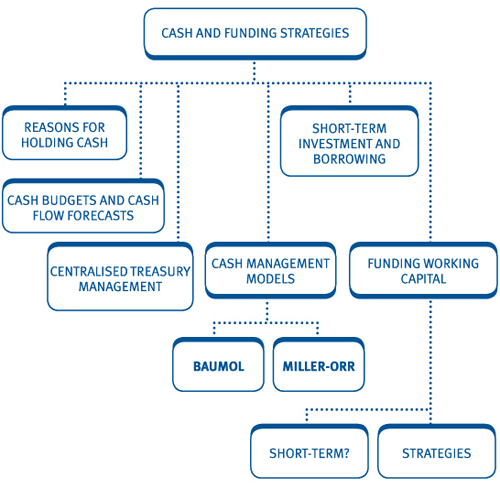
1 Reasons for holding cash
Although cash needs to be invested to earn returns, businesses need to keep a certain amount readily available. The reasons include:
- transactions motive
- precautionary motive
- investment motive.
Failure to carry sufficient cash levels can lead to:
- loss of settlement discounts
- loss of supplier goodwill
- poor industrial relations
- potential liquidation.

 Reasons for holding cash
Reasons for holding cash
Cash is required for a number of reasons:
Transactions motive – cash required to meet day-to-day expenses, e.g. payroll, payment of suppliers, etc.
Precautionary motive – cash held to give a cushion against unplanned expenditure (the cash equivalent of buffer inventory).
Speculative motive – cash kept available to take advantage of market investment opportunities.
The cost of running out of cash depends on the firm's particular circumstances but may include not being able to pay debts as they fall due which can have serious operational repercussions:
- trade suppliers refuse to offer further credit, charge higher prices or downgrade the priority with which orders are processed
- if wages are not paid on time, industrial action may well result, damaging production in the short-term and relationships and motivation in the medium-term
- the court may be petitioned to wind up the company if it consistently fails to pay bills as they fall due.

Once again therefore the firm faces a balancing act between liquidity and profitability.

 The balancing act
The balancing act

 Remember to consider the three motives for holding cash and the liquidity/profitability trade-off in a question that asks for a discussion of cash management.
Remember to consider the three motives for holding cash and the liquidity/profitability trade-off in a question that asks for a discussion of cash management.
2 Cash budgets and cash flow forecasts
 A cash forecast is an estimate of cash receipts and payments for a future period under existing conditions.
A cash forecast is an estimate of cash receipts and payments for a future period under existing conditions.
A cash budget is a commitment to a plan for cash receipts and payments for a future period after taking any action necessary to bring the forecast into line with the overall business plan.
Cash budgets are used to:
- assess and integrate operating budgets
- plan for cash shortages and surpluses
- compare with actual spending.
Cash forecasts can be prepared based on:
- Receipts and payments forecast. This is a forecast of cash receipts and payments based on predictions of sales and cost of sales and the timings of the cash flows relating to these items.
- Balance sheet (statement of financial position) forecast. This is a forecast derived from predictions of future balance sheets. Predictions are made of all items except cash, which is then derived as a balancing figure.
- Working capital ratios. Future cash and funding requirements can be determined from the working capital ratios seen in the chapter on working capital management.
You could be asked to do any of these in the exam.

 Cash budgets and cash flow forecasts
Cash budgets and cash flow forecasts
It is important to distinguish between a budget and a forecast. A cash forecast is an estimate of cash receipts and payments for a future period under existing conditions before taking account of possible actions to modify cash flows, raise new capital, or invest surplus funds.
A cash budget is a commitment to a plan for cash receipts and payments for a future period after taking any action necessary to bring the preliminary cash forecast into conformity with the overall plan of the business.
Companies are likely to prepare a cash budget as part of the annual master budget, but then to continually prepare revised cash forecasts throughout the year, as a means of monitoring and managing cash flows.


 Using planned receipts and payments
Using planned receipts and payments
Preparing a cash flow forecast from receipts and payments
Every type of cash inflow and receipt, along with their timings, must be forecast. Note that cash receipts and payments differ from sales and cost of sales in the income statement because:
- not all cash receipts or payments affect the income statement, e.g. the issue of new shares or the purchase of a non-current asset
- some income statement items are derived from accounting conventions and are not cash flows, e.g. depreciation or the profit/loss on the sale of a non-current asset
- the timing of cash receipts and payments does not coincide with the income statement accounting period, e.g. a sale is recognised in the income statement when the invoice is raised, yet the cash payment from the receivable may not be received until the following period or later.
The following approach should be adopted for examination questions.
Step 1 – Prepare a proforma
Step 2 – Fill in the simple figures
Some payments need only a small amount of work to identify the correct figure and timing and can be entered straight into the proforma. These would usually include:
- wages and salaries
- fixed overhead expenses
- dividend payments
- purchase of non-current assets.
Step 3 – Work out the more complex figures
The information on sales and purchases can be more time consuming to deal with, e.g.:
- timings for both sales and purchases must be found from credit periods
- variable overheads may require information about production levels
- purchase figures may require calculations based on production schedules and inventory balances.


 Additional question - Full cash flow forecast
Additional question - Full cash flow forecast
In the near future a company will purchase a manufacturing business for $315,000, this price to include goodwill ($150,000), equipment and fittings ($120,000), and inventory of raw materials and finished goods ($45,000).
A delivery van will be purchased for $15,000 as soon as the business purchase is completed. The delivery van will be paid for in the second month of operations.
The following forecasts have been made for the business following purchase:
(i)Sales (before discounts) of the business’s single product, at a mark-up of 60% on production cost will be:
25% of sales will be for cash; the remainder will be on credit, for settlement in the month following that of sale. A discount of 10% will be given to selected credit customers, who represent 25% of gross sales.
(ii) Production cost will be $5 per unit. The production cost will be made up of:
(iii)Production will be arranged so that closing inventory at the end of any month is sufficient to meet sales requirements in the following month. A value of $30,000 is placed on the inventory of finished goods, which was acquired on purchase of the business. This valuation is based on the forecast of production cost per unit given in (ii) above.
(iv)The single raw material will be purchased so that inventory at the end of a month is sufficient to meet half of the following month’s production requirements. Raw material inventory acquired on purchase of the business ($15,000) is valued at the cost per unit that is forecast as given in (ii) above. Raw materials will be purchased on one month’s credit.
(v) Costs of direct labour will be met as they are incurred in production.
(vi) The fixed production overhead rate of $1.00 per unit is based upon a forecast of the first year’s production of 150,000 units. This rate includes depreciation of equipment and fittings on a straight-line basis over the next five years. Fixed production overhead is paid in the month incurred.
(vii) Selling and administration overheads are all fixed, and will be $208,000 in the first year. These overheads include depreciation of the delivery van at 30% pa on a reducing balance basis. All fixed overheads will be incurred on a regular basis, and paid in the month incurred, with the exception of rent and rates. $25,000 is payable for the year ahead in month one for rent and rates.
Requirements
(a)Prepare a monthly cash flow forecast. You should include the business purchase and the first four months of operations following purchase.
(b)Calculate the inventory, receivables, and payables balances at the end of the four-month period. Comment briefly upon the liquidity situation.
The answer to this question can be found after the chapter summary diagram at the end of this chapter.


 Using a statement of financial position
Using a statement of financial position
Preparing a cash flow forecast from a statement of financial position
Used to predict the cash balance at the end of a given period, this method will typically require forecasts of:
- changes to non-current assets (acquisitions and disposals)
- future inventory levels
- future receivables levels
- future payables levels
- changes to share capital and other long-term funding (e.g. bank loans)
- changes to retained profits.


 Additional question - Statement of financial position
Additional question - Statement of financial position
Zed Co has the following statement of financial position at 30 June 20X3:

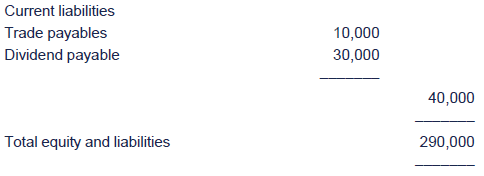
(a)The company expects to acquire further plant and machinery costing $8,000 during the year to 30 June 20X4.
(b)The levels of inventories and receivables are expected to increase by 5% and 10% respectively by 30 June 20X4, due to business growth.
(c)Trade payables and dividend liabilities are expected to be the same at 30 June 20X4.
(d)No share issue is planned, and retained profits for the year to 30 June 20X4 are expected to be $42,000.
(e)Plant and machinery is depreciated on a reducing balance basis, at the rate of 20% pa, for all assets held at the balance sheet date.
Required:
Produce a financial position statement forecast as at 30 June 20X4, and predict what the cash balance or bank overdraft will be at that date.
The answer to this question can be found after the chapter summary diagram at the end of this chapter.


 Using working capital ratios
Using working capital ratios
Preparing a cash flow forecast from working capital ratios
Working capital ratios can also be used to forecast future cash requirements.
The first stage is to use the ratios to work out the working capital requirement, as we have already seen in the working capital management chapter.
This technique is used to help forecast overall cash flow. The proforma below is used.
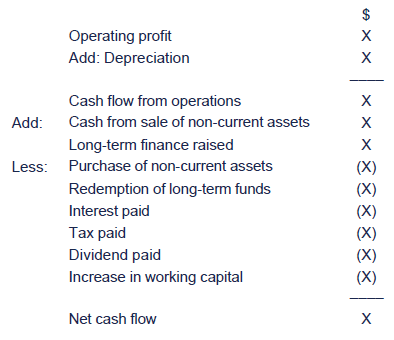
Note that the proforma given is not strictly in accordance with International Accounting Standards, which govern the production of cash flow statements in a company's financial statements. However, here we are calculating projected future cash flows rather that the historical cash flow that is covered by the standards.


 Additional question - Forecasts from working capital ratios
Additional question - Forecasts from working capital ratios

Statement of financial position (extract)
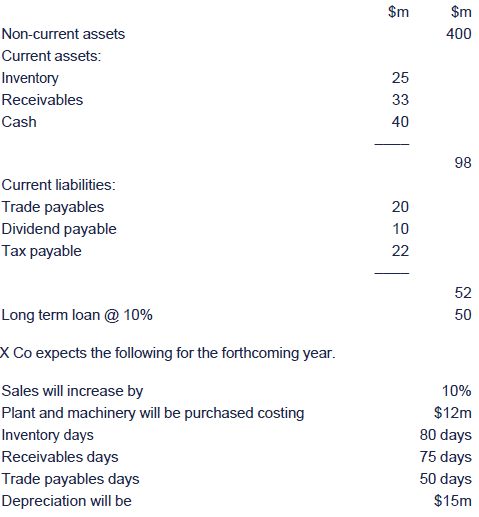
Required:
Prepare a cash flow projection for the forthcoming period.
The answer to this question can be found after the chapter summary diagram at the end of this chapter.

3 Treasury management
The role of treasury management
Treasury management is concerned with liquidity and covers the following activities:
- banking and exchange
- cash and currency management
- investment in short-term assets
- risk and insurance
- raising finance.
The case for centralising treasury management
A company must choose between having its treasury management:
- centralised
- decentralised
If they are centralised, each operating company holds only the minimum cash balance required for day-to-day operations, remitting the surplus to the centre for overall management.
If they are decentralised, each operating company must appoint an officer responsible for that company's own treasury operations.
 Ensure you can discuss the key arguments.
Ensure you can discuss the key arguments.
Centralised treasury management often results in a highly-skilled team, cheaper borrowing, lower bank charges and more effective hedging of currency risk, but some motivational and local knowledge benefits may be lost.

 Treasury management
Treasury management
All treasury management activities are concerned with managing the liquidity of a business, the importance of which to the survival and growth of a business cannot be over-emphasised.
Why have a treasury department?
The functions carried out by the treasurer have always existed, but have been absorbed historically within other finance functions. A number of reasons may be identified for the modern development of separate treasury departments:
- size and internationalisation of companies: these factors add to both the scale and the complexity of the treasury functions
- size and internationalisation of currency, debt and security markets: these make the operations of raising finance, handling transactions in multiple currencies and investing, much more complex. They also present opportunities for greater gains
- sophistication of business practice: this process has been aided by modern communications, and as a result the treasurer is expected to take advantage of opportunities for making profits or minimising costs which did not exist a few years ago.
For these reasons, most large international corporations have moved towards setting up a separate treasury department.
Treasury departments tend to rely heavily on new technology for information.
Treasury responsibilities
The treasurer will generally report to the finance director (financial manager), with a specific emphasis on borrowing and cash and currency management. The treasurer will have a direct input into the finance director's management of debt capacity, debt and equity structure, resource allocation, equity strategy and currency strategy.
The treasurer will be involved in investment appraisal, and the finance director will often consult the treasurer in matters relating to the review of acquisitions and divestments, dividend policy and defence from takeover.
Treasury departments are not large, since they are not involved in the detailed recording of transactions.
Centralisation of treasury activities
Should treasury activities in a large international group be centralised or decentralised?
Advantages of centralisation are as follows.
- There is no need for treasury skills to be duplicated throughout the organisation. One highly-trained central department can assemble a highly-skilled team, offering skills that could not be available if every company had their own treasury.
- Necessary borrowings can be arranged in bulk, at keener interest rates than for smaller amounts. Similarly bulk deposits of surplus funds will attract higher rates of interest than smaller amounts.
- The group's foreign currency risk can be managed much more effectively from a centralised treasury, since only the treasury department can appreciate the total exposure situation. A total hedging policy is more efficiently carried out by head office, rather than each company doing its own hedging.
- Bank charges should be lower, since the carrying of both balances and overdrafts in the same currency should be eliminated.
Advantages of decentralisation are as follows.
- Greater autonomy leads to greater motivation. Individual companies will manage their cash balances more attentively if they are responsible for them, rather than simply remitting them up to head office.
- Local operating units should have a better feel for local conditions than head office and can respond more quickly to local developments.

4 Cash management models
Cash management models are aimed at minimising the total costs associated with movements between:
- a current account (very liquid but not earning interest) and
- short-term investments (less liquid but earning interest).
The models are devised to answer the questions:
- at what point should funds be moved?
- how much should be moved in one go?
The Baumol cash management model
Baumol noted that cash balances are very similar to inventory levels, and developed a model based on the economic order quantity (EOQ).
Assumptions:
- cash use is steady and predictable
- cash inflows are known and regular
- day-to-day cash needs are funded from current account
- buffer cash is held in short-term investments.
The formula calculates the amount of funds to inject into the current account or to transfer into short-term investments at one time:
where:
CO = transaction costs (brokerage,commission, etc.)
D = demand for cash over the period
CH = cost of holding cash.
 The model suggests that when interest rates are high, the cash balance held in non-interest-bearing current accounts should be low. However its weakness is the unrealistic nature of the assumptions on which it is based.
The model suggests that when interest rates are high, the cash balance held in non-interest-bearing current accounts should be low. However its weakness is the unrealistic nature of the assumptions on which it is based.

 Explanation of terminology
Explanation of terminology
CO = transaction costs are the costs of making a trade in securities or moving funds in and out of interest-bearing deposit accounts.
D = the demand for cash over the period relates to cash needs for day-to-day transactions.
CH = the cost of holding cash will be the opportunity cost relating to either the return it could have earned in marketable securities or deposit accounts or the cost of borrowing in order to acquire cash.


 Test your understanding 1 – Baumol
Test your understanding 1 – Baumol
A company generates $10,000 per month excess cash, which it intends to invest in short-term securities. The interest rate it can expect to earn on its investment is 5% pa. The transaction costs associated with each separate investment of funds is constant at $50.
Required:
(a)What is the optimum amount of cash to be invested in each transaction?
(b)How many transactions will arise each year?
(c)What is the cost of making those transactions pa?
(d)What is the opportunity cost of holding cash pa?


 Test your understanding 2 – Baumol
Test your understanding 2 – Baumol
A company faces a constant demand for cash totalling $200,000 pa. It replenishes its current account (which pays no interest) by selling constant amounts of treasury bills which are held as an investment earning 6% pa. The cost per sale of treasury bills is a fixed $15 per sale.
What is the optimum amount of treasury bills to be sold each time an injection of cash is needed in the current account, how many transfers will be needed and what will the overall transaction cost be?

The Miller-Orr cash management model
The Miller-Orr model controls irregular movements of cash by the setting of upper and lower control limits on cash balances.
 The Miller-Orr model is used for setting the target cash balance.
The Miller-Orr model is used for setting the target cash balance.
It has the advantage of incorporating uncertainty in the cash inflows and outflows.
The diagram below shows how the model works over time.
- The model sets higher and lower control limits, H and L, respectively, and a target cash balance, Z.
- When the cash balance reaches H, then (H-Z) dollars are transferred from cash to marketable securities, i.e. the firm buys (H-Z) dollars of securities.
- Similarly when the cash balance hits L, then (Z-L) dollars are transferred from marketable securities to cash.
The lower limit, L is set by management depending upon how much risk of a cash shortfall the firm is willing to accept, and this, in turn, depends both on access to borrowings and on the consequences of a cash shortfall.
The formulae (given in the examination) for the Miller-Orr model are:
Return point = Lower limit + (1/3 × spread)
Spread = 3 [ (3/4 × Transaction cost × Variance of cash flows) ÷ Interest rate ] 1/3
Note: variance and interest rates should be expressed in daily terms. If the question provides you with the standard deviation of daily cash flows, you will need to square this number to obtain the variance.

 Miller Orr
Miller Orr
The Miller-Orr model controls irregular movements of cash by the use of upper and lower limits on cash balances.
The lower limit has to be specified by the firm and the upper limit is calculated by the model. The cash balance of the firm is allowed to vary freely between the two limits but if the cash balance on any day goes outside these limits, action must be taken.
If the cash balance reaches the lower limit it must be replenished in some way, e.g. by the sale of marketable securities or withdrawal from a deposit account. The size of this withdrawal is the amount required to take the balance back to the return point. It is the distance between the return point (usually set in Miller-Orr as the lower limit plus one third of the distance up to the upper limit) and the lower limit.
If the cash balance reaches the upper limit, an amount must be invested in marketable securities or placed in a deposit account, sufficient to reduce the balance back to the return point. Again, this is calculated by the model as the distance between the upper limit and the return point.
The minimum cost upper limit is calculated by reference to brokerage costs, holding costs and the variance of cash flows. The model has some fairly restrictive assumptions, e.g. normally distributed cash flows but, in tests, Miller and Orr found it to be fairly robust and claim significant potential cost savings for companies.


 Test your understanding 3 – Miller Orr
Test your understanding 3 – Miller Orr
The minimum cash balance of $20,000 is required at Miller-Orr Co, and transferring money to or from the bank costs $50 per transaction. Inspection of daily cash flows over the past year suggests that the standard deviation is $3,000 per day, and hence the variance (standard deviation squared) is $9 million. The interest rate is 0.03% per day.
Calculate:
(i)the spread between the upper and lower limits
(ii) the upper limit
(iii)the return point.


 Test your understanding 4 – Miller Orr
Test your understanding 4 – Miller Orr
A company sets its minimum cash balance at $5,000 and has estimated the following:
- transaction cost = $15 per sale or purchase of gilts
- standard deviation of cash flows = $1,200 per day (i.e. variance = $1.44 million per day)
- interest rate = 7.3% pa = 0.02% per day.
(i)What is the spread between the upper and lower limits?
(ii) What is the upper limit?
(iii)What is the return point?

5 Short-term investment and borrowing solutions
The cash management models discussed above assumed that funds could be readily obtained when required either by liquidating short-term investments or by taking out short-term borrowing.
A company must choose from a range of options to select the most appropriate source of investment/funding.
Short-term cash investments
Short-term cash investments are used for temporary cash surpluses. To select an investment, a company has to weigh up three potentially conflicting objectives and the factors surrounding them.
The objectives can be categorised as follows:
Liquidity: the cash must be available for use when needed.
Safety: no risk of loss must be taken.
Profitability: subject to the above, the aim is to earn the highest possible after-tax returns.
 Ensure you can discuss the three key objectives affecting the choice of short-term investment.
Ensure you can discuss the three key objectives affecting the choice of short-term investment.

 Short-term investment
Short-term investment
Short-term investment opportunities present themselves when cash surpluses arise. The company's attitude to risk and working capital management will determine the planned cash holdings. This section deals with the practical aspects of the management of a portfolio of short-term investments.
Surplus cash comprises liquid balances held by a business, which are neither needed to finance current business operations nor held permanently for short-term investment. The availability of surplus cash is temporary, awaiting employment either in existing operations or in new investment opportunities (whether already identified or not). The 'temporary' period can be of any duration, from one day to the indefinite future date at which the new investment opportunity may be identified and seized.
Where balances are held temporarily for conversion to other, more important, business uses, absolute priority must be given to the avoidance of risk over maximising returns. The usual principle of finding the optimal mix between risk and return does not apply here, because the investment is secondary and incidental to the ultimate business use of the asset, not an end in itself.
Objectives in the investment of surplus cash
Each of the three objectives raises problems.
The liquidity problem
At first sight this problem is simple enough. If a company knows that it will need the funds in three days (or weeks or months), it simply invests them for just that period at the best rate available with safety. The solution is to match the maturity of the investment with the period for which the funds are surplus. However there are a number of factors to consider:
- The exact duration of the surplus period is not always known. It will be known if the cash is needed to meet a loan instalment, a large tax payment or a dividend. It will not be known if the need is unidentified, or depends on the build-up of inventory, the progress of construction work, or the hammering out of an acquisition deal.
- Expected future trends in interest rates (see below) affect the maturity of investments.
- Bridging finance may be available to bridge the gap between the time when the cash is needed and the subsequent date on which the investment matures.
- An investment may not need to be held to maturity, if either an earlier withdrawal is permitted by the terms of the instrument without excessive penalty, or there is a secondary market and its disposal in that market causes no excessive loss.
- A good example of such an investment is a certificate of deposit (CD), where the investor 'lends' the bank a stated amount for a stated period, usually between one and six months. As evidence of the debt and its promise to pay interest, the bank gives the investor a CD. There is an active market for CDs issued by the commercial banks and turning a CD into cash is easy and cheap.
The safety problem
Safety means there is no risk of capital loss. Superficially this again looks simple. The concept certainly includes the absence of credit risk. For example, the firm should not deposit with a bank which might conceivably fail within the maturity period and thus not repay the amount deposited.
However, safety is not necessarily to be defined as certainty of getting the original investment repaid at 100% of its original home currency value. If the purpose for which the surplus cash is held is not itself fixed in the local currency, then other criteria of safety may apply.
Examples
If the cash is being held to meet a future commitment, the ultimate amount of the commitment may be subject to inflationary rises (e.g. payment to building contractors for a new factory). In this case a safer investment instrument may be an index-linked gilt-edged bond with a maturity date close to the expected date of the payment.
The profitability problem
If the cash is being held to meet a future payment in a foreign currency, the only riskless investment would be one denominated in that currency.
The profitability objective looks deceptively simple at first: go for the highest rate of return subject to the overriding criteria of safety and liquidity. However, here there are even more complications.
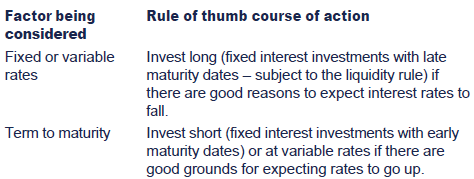
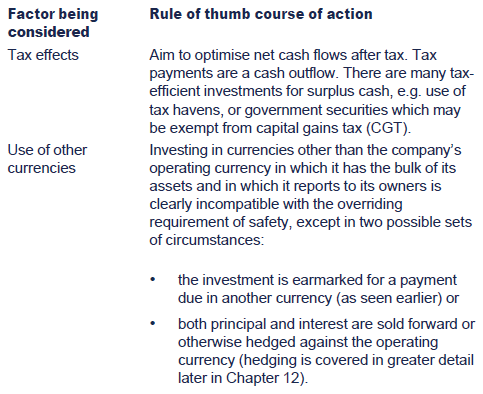


Short-term borrowing
Short-term cash requirements can also be funded by borrowing from the bank. There are two main sources of bank lending:
- bank overdraft
- bank loans.
Bank overdrafts are mainly provided by the clearing banks and are an important source of company finance.

Bank loans are a contractual agreement for a specific sum, loaned for a fixed period, at an agreed rate of interest. They are less flexible and more expensive than overdrafts but provide greater security.

 Short-term borrowing
Short-term borrowing
Finance costs on bank loans and overdrafts are normally variable, i.e. they alter in line with base rates. Fixed rate loans are available, but are less popular with firms (and providers of finance).
Bank overdrafts
A common source of short-term financing for many businesses is a bank overdraft. These are mainly provided by the clearing banks and represent permission by the bank to write cheques even though the firm has insufficient funds deposited in the account to meet the cheques.
An overdraft limit will be placed on this facility, but provided the limit is not exceeded, the firm is free to make as much or as little use of the overdraft as it desires. The bank charges interest on amounts outstanding at any one time, and the bank may also require repayment of an overdraft at any time.
The advantages of overdrafts are the following.
- Flexibility – they can be used as required.
- Cheapness – interest is only payable on the finance actually used, usually at 2-5% above base rate (and all loan interest is a tax deductible expense).
The disadvantages of overdrafts are as follows.
- Overdrafts are legally repayable on demand. Normally, however, the bank will give customers assurances that they can rely on the facility for a certain time period, say six months.
- Security is usually required by way of fixed or floating charges on assets or sometimes, in private companies and partnerships, by personal guarantees from owners.
- Interest costs vary with bank base rates. This makes it harder to forecast and exposes the business to future increases in interest rates.
Overall, bank overdrafts are one of the most important sources of short-term finance for industry.
Bank loans
A bank loan represents a formal agreement between the bank and the borrower, that the bank will lend a specific sum for a specific period (one to seven years being the most common). Interest must be paid on the whole of this sum for the duration of the loan.
This source is, therefore, liable to be more expensive than the overdraft and is less flexible but, on the other hand, there is no danger that the source will be withdrawn before the expiry of the loan period. Interest rates and requirements for security will be similar to overdraft lending.
Comparison of bank loans and overdrafts
Consider a company that requires a maximum of $600 over the next four months. However, it is only halfway through month four that it actually requires the full amount.
The difference can be shown as follows:
 Bank loan
Bank loan
If an overdraft is used, the company will pay interest on the maximum amount part way through month 4. For the remainder of the period it will pay interest on an overdraft of substantially less than that, or it will pay no interest at all as it has a positive bank balance. If it borrows $600 by way of a bank loan at the beginning of the four months, it must pay interest for four months on the amount borrowed, despite the fact that it rarely requires the full sum.


 Calculation of repayment on a loan
Calculation of repayment on a loan
The annual repayments on a loan can be calculated using the annuity factors seen in chapter 3.
For example, a $100,000 loan taken out by a buisness at a rate of 7%, repayable over 5 years will have annual repayments of:

where 4.100 is the 7 year, 5% annuity factor.
Each payment can then be split between the repayment of capital and interest on the outstanding balance.
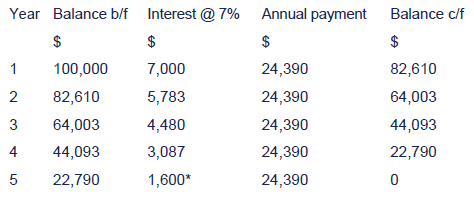

6 Strategies for funding working capital
In the same way as for long-term investments, a firm must make a decision about what source of finance is best used for the funding of working capital requirements.
The decision about whether to choose short- or long-term options depends upon a number of factors:
- the extent to which current assets are permanent or fluctuating
- the costs and risks of short-term finance
- the attitude of management to risk
Permanent or fluctuating current assets
In most businesses a proportion of the current assets are fixed over time, i.e. 'permanent'. For example:
- buffer inventory,
- receivables during the credit period,
- minimum cash balances.
The choice of how to finance the permanent current assets is a matter for managerial judgement, but includes an analysis of the cost and risks of short-term finance.

 Costs and risks of short-term finance
Costs and risks of short-term finance
The cost of short-term finance
Short-term finance is usually cheaper than long-term finance. This is largely due to the risks taken by creditors. For example, if a bank were considering two loan applications, one for one year and the other for 20 years, all other things being equal it would demand a higher interest rate on the 20-year loan. This is because it feels more exposed to risk on long-term loans, as more could go wrong with the borrower over a period of twenty years than a period of one year (although it should be noted that occasionally this situation is reversed, with rates of return being higher on short-term finance).
Short-term finance also tends to be more flexible. For example, if funds are raised on overdraft and used to finance a fluctuating investment in current assets, they can be paid off when not required and interest saved. On the other hand, if funds were borrowed for the long term, early repayment may not be possible, or, if allowed, early repayment penalties may be experienced. The flexibility of short-term finance may, therefore, reduce its overall cost.
Short-term finance includes items such as trade payables, which are normally regarded as low cost funds, whereas long-term finance will include debt and equity. Equity finance is particularly expensive, its required returns being high, and non-tax deductible.
The risks of short-term finance
Short-term financing has already been established as generally 'the cheaper option'. However, the price paid for reduced cost is increased risk for the borrower.
There may be:
Renewal problems – short-term finance may need to be continually renegotiated as various facilities expire and renewal may not always be guaranteed.
Unstable interest rates – if the company constantly has to renew its funding arrangements, it will be at the mercy of fluctuations in short-term interest rates.

The attitude of management to risk: aggressive, conservative and matching funding policies
There is no ideal funding package, but three approaches may be identified.
- Aggressive – finance most current assets, including 'permanent' ones, with short-term finance. Risky but profitable.
- Conservative – long-term finance is used for most current assets, including a proportion of fluctuating current assets. Stable but expensive.
- Matching – the duration of the finance is matched to the duration of the investment.

 The attitude of management to risk
The attitude of management to risk
Illustration – Aggressive, conservative and matching funding policies
The following three companies have current asset financing structures that may be considered as aggressive, matching and conservative:
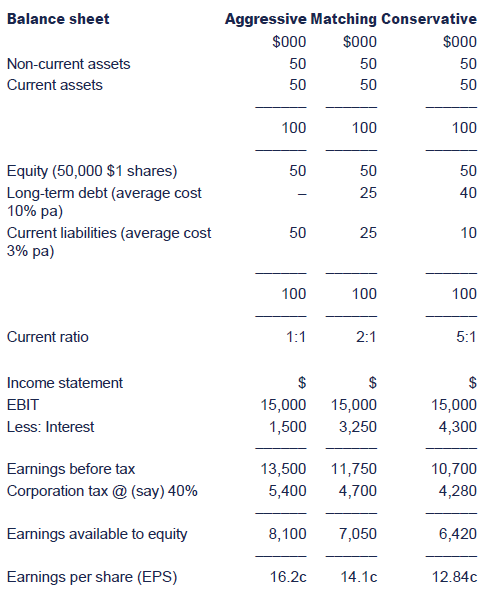
The aggressive company is so termed as it is prepared to take the risk of financing more of its business investment with short-term credit. The defensive company, at the other 'extreme', takes on board a high proportion of longer-term debt with, consequently, less short-term credit risk.
It can be seen that the aggressive company returns a higher profit but at the cost of greater risk. It is interesting to note that this higher risk is revealed in its relatively poor current ratio.

 Essentially the final choice of working capital funding is down to the management of the individual companies, bearing in mind:
Essentially the final choice of working capital funding is down to the management of the individual companies, bearing in mind:
- the willingness of creditors to lend
- the risks of their commercial sector

 Funding strategies for smaller companies
Funding strategies for smaller companies
Smaller companies may, by necessity, finance almost all their needs from short-term finance, since long-term debt and equity may be difficult to raise without marketable shares and a good track record.
If the commercial sector in which the company operates has volatile earnings, management may consider it best to take a conservative approach to funding to avoid particular problems in problem years.
The attitude to risk of the decision maker will ultimately determine the decision taken (see chapter 12 for more analysis of attitude to risk), and this in turn may be influenced by the attitudes and decisions of those who have gone before.

Chapter summary

 Answer to additional question - Full cash flow forecast
Answer to additional question - Full cash flow forecast
(a) Monthly cash budget
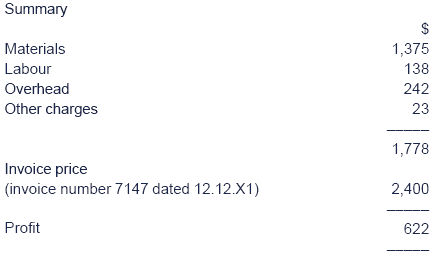

Workings
(W1)
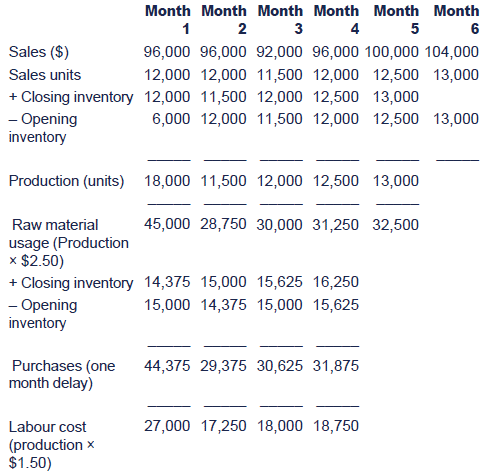
(W2) – Production overheads

(W3) – Selling and administration overheads
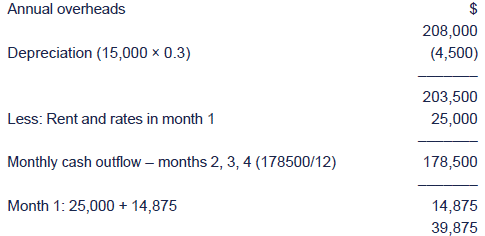
(b) Closing balances:
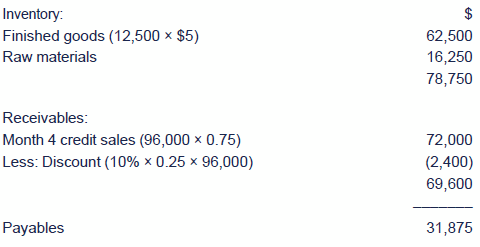
Apart from the purchase of the business, which will require separate long-term finance, the cash flow forecast suggests that there will be sufficient cash inflows to meet the cash outflows on an ongoing basis. The current assets and receivables provide sufficient funds to cover the payables.


 Answer to additional question - Statement of financial position
Answer to additional question - Statement of financial position
Zed Co – Statement of financial position at 30 June 20X4

The forecast is that the bank balance will increase by $65,200 (i.e. $67,200 – $2,000). This can be reconciled as follows:
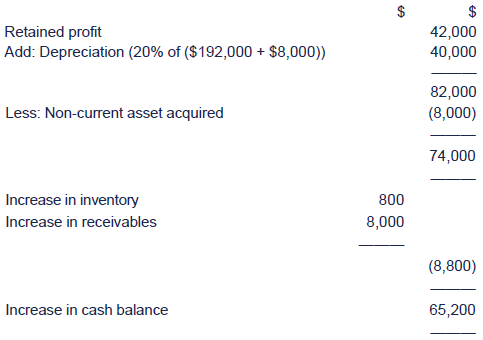


 Answer to additional question - Forecasts from working capital ratios
Answer to additional question - Forecasts from working capital ratios
Here we will assume that the gross profit percentage will remain unaltered in cash terms.
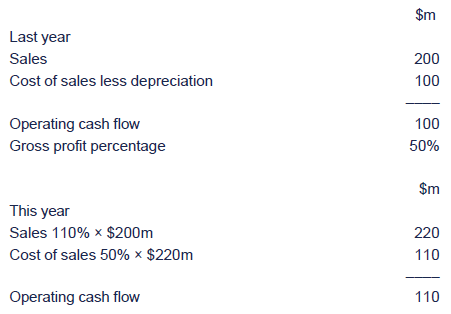
Next we calculate the working capital requirements (to the nearest $m).

Notes
(1)We have already calculated operating cash flow so do not need to adjust for depreciation of $15m.
(2)It is assumed that this is the same as last period, as the loans have not changed.
(3)The tax and dividend payables in last year’s balance sheet will be paid in the forthcoming period
(4)This was given in the question.
(5)Increases in current assets are an outflow, reductions are an inflow. The reverse is the case for trade payables.

Test your understanding answers

 Test your understanding 1 – Baumol
Test your understanding 1 – Baumol
Solution

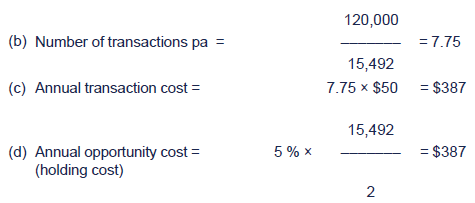


 Test your understanding 2 – Baumol
Test your understanding 2 – Baumol
The optimum amount of treasury bills sold, Q, for each cash injection into the current account will be:
Q = √(2 x 200,000 × 15 ÷ 0.06) = $10,000
The total number of transactions will be
200,000 ÷ 10.000 = 20
and the total transaction cost will be 20 × $15 = $300.


 Test your understanding 3 – Miller Orr
Test your understanding 3 – Miller Orr
(i)Spread = 3 (3/4 × 50 × 9,000,000/0.0003)1/3 = $31,200
(ii) Upper limit = 20,000 + 31,200 = $51,200
(iii)Return point = 20,000 + 31,200/3 = $30,400


 Test your understanding 4 – Miller Orr
Test your understanding 4 – Miller Orr
The spread is calculated as:
3 × [(3/4 ×15 × 1.44m) ÷ 0.0002]1/3
= 3 × $4,327
= $12,981
Therefore:
- lower limit (set by the company) = $5,000
- upper limit = 5,000 + 12,981 = $17,981
- return point = 5,000 + ( 1/3 × 12,981) = $9,327.

|
Created at 10/4/2012 8:45 AM by System Account
(GMT) Greenwich Mean Time : Dublin, Edinburgh, Lisbon, London
|
Last modified at 10/4/2012 8:45 AM by System Account
(GMT) Greenwich Mean Time : Dublin, Edinburgh, Lisbon, London
|
|
|
|
 |
Rating
:
|
 Ratings & Comments
(Click the stars to rate the page) Ratings & Comments
(Click the stars to rate the page)
|
 |
Tags:
|
|